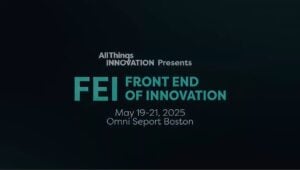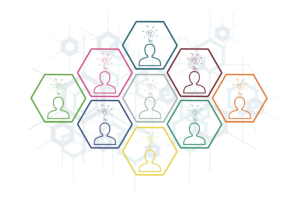Reinventing Culture Change
Technology evolution is certainly a big part of the disruptive change in society, as is the drive for efficiency. Yet, design thinking, plus organizational and individual agility, is in part built to overcome this and fulfill the needs of business transformation.
“The capability to redefine value through new products, services and solutions, is built upon an innovative mindset, creativity, the courage to take risks and an openness to change,” says co-authors Luke Battye and Hema Bakhshi of behavioral design consultancy Sprint Valley, in the article, “Using Design Thinking to Create Culture Change,” from Innovation Training’s website.
The authors make the case that design thinking can help to create change. They write, “The value of design thinking, is that it focuses on problems that are complex by nature, and on problems that are focused on people. The steps broadly follow the Design Thinking philosophy (Immerse, Frame, Ideate, Prototype, Test) but with some important nuance that’s specifically relevant for navigating change in larger organizations.” Some design thinking-oriented and culture-forming tips that they share include:
- Build a Tiger Team: You need a team to deliver change. You should assemble a group of 7-10 individuals who bring unique perspectives to the table (e.g. HR vs. finance). These are people who will ultimately be responsible for driving change through the various departments and business units of the company.
- Behaviors First, Culture Second: This is where the rubber meets the road. The tangible, ‘hard stuff’ that you can observe, understand, influence and change. It’s when we focus on this level of culture, the day to day behaviors, that we can make small changes that can have dramatic consequences.
- It’s a Marathon, Not a Sprint: Culture change takes time. You should be setting expectations internally that your first year is about learning and experimentation, year two is rollout and adoption and year three moves towards these new behaviors being self-perpetuating.
- Help Your Team Trip Over the Truth: This means getting your team out into the business, having real conversations with real people. This is something people dread, but consistently find energizing and inspiring.
- You Can’t Outsource, ‘A-ha!’: An insight is a deeply personal moment of realization. It’s the feeling of identifying a new pattern or relationship between two things that you couldn’t see before. For this insight to motivate behavior and really drive change — it must be felt, and it must be yours.
The authors further discuss a learning versus thinking approach. “The complexity of the environment will dictate our approach: simple environments allow us to quickly apply best practice. Complicated environments require slightly more cross-functional thinking and so we can be satisfied with ‘good’ practice. But the moment we move into complex environments, our approach needs to change. We’ve moved beyond best practice, and we now need to create ‘emergent practice’. This means testing and learning quickly.”
Learning Versus Thinking
At FEI, All Things Innovation conducted a special roundtable, bringing cross industry, cross disciplinarians together to talk about transformation and how to make it a reality. In Part 1, we focused on the concept of transformational innovation and covered many angles of the theme, such as people-centricity, technology, and disruption. Here in Part 2, “Supporting Data with Design Thinking,” we ask, how might design thinking play into this scenario?
Looking forward to FEI 2024? The conference, which will be held June 10 to 12, will feature a session called “Business Transformation: Design Thinking, Change Management & Cultural Evolution To Drive Growth,” presented by Christian Saclier, VP Design Innovation, PepsiCo. Everything, everywhere, all at once. We know that how we do what we do is evolving. The goal is to be the progenitor of that change. When design thinking is coursing through the veins of an organization, anything is possible and evolution becomes certain. Join us as we discuss creating a design thinking culture to drive growth. Register for FEI 2024 here.
The Right Mindset
Design thinking culture can significantly drive business transformation and growth by fostering a mindset centered on empathy, collaboration, and innovation. Here are the top ten factors, according to ChatGPT, that showcase the impact of a design thinking culture on business transformation and growth:
- Customer-Centric Solutions: Design thinking places a strong emphasis on understanding and empathizing with customer needs. By prioritizing customer-centric solutions, businesses can create products and services that truly address the challenges and desires of their target audience, leading to increased customer satisfaction and loyalty.
- Innovation and Creativity: A design thinking culture encourages a creative and innovative approach to problem-solving. This mindset promotes thinking beyond conventional solutions, allowing businesses to develop unique and disruptive ideas that can propel growth and set them apart in the market.
- Cross-Functional Collaboration: Design thinking encourages collaboration among individuals with diverse skills and backgrounds. Breaking down silos and promoting cross-functional collaboration enhances communication, facilitates the exchange of ideas, and accelerates the development of comprehensive and well-rounded solutions.
- Iterative Prototyping: The iterative nature of design thinking involves creating prototypes and gathering feedback early and often. This approach enables businesses to quickly test and refine ideas, minimizing the risks associated with large-scale implementation. It also facilitates a more agile response to changing market dynamics.
- User Feedback Integration: Continuous feedback loops with end-users are a core aspect of design thinking. By integrating user feedback throughout the development process, businesses can refine their offerings based on real-world experiences, ensuring that the final product or service resonates with the intended audience.
- Risk Mitigation: Design thinking provides a structured yet flexible framework for addressing complex problems. By breaking down challenges into manageable components and systematically testing solutions, businesses can mitigate risks associated with large-scale transformations, enhancing the likelihood of success.
- Empowered Teams: Design thinking empowers teams to take ownership of their projects. This autonomy fosters a sense of responsibility and encourages team members to explore unconventional ideas, leading to a more engaged and motivated workforce.
- Adaptability to Change: The iterative nature of design thinking instills a mindset of adaptability. Businesses that embrace design thinking are better equipped to navigate and respond to rapidly changing market conditions, ensuring they stay ahead of the competition.
- Alignment with Business Goals: Design thinking is aligned with business objectives, ensuring that innovative solutions contribute directly to overarching goals. This strategic alignment enhances the impact of design thinking on business transformation and growth by focusing efforts on areas that drive measurable results.
- Cultural Transformation: Implementing a design thinking culture requires a shift in organizational mindset. This cultural transformation, emphasizing empathy, openness to new ideas, and a willingness to learn from failure, creates a dynamic environment that supports continuous innovation and sustainable business growth.
Customer Central
A design thinking culture drives business transformation and growth by placing customers at the center of the innovation process, fostering creativity and collaboration, and instilling an adaptive and user-centric mindset throughout the organization. While there is no instruction manual on culture change within a company, design thinking can be a roadmap to the landscape. As Innovation Training notes in its blog, “It’s through this process of discovery, collaboration and experimentation you’ll help your organization develop new competencies, confidence and behaviors of the future.”
Video courtesy of Columbia Business School
Contributor
-

Matthew Kramer is the Digital Editor for All Things Insights & All Things Innovation. He has over 20 years of experience working in publishing and media companies, on a variety of business-to-business publications, websites and trade shows.
View all posts



























































































































































































